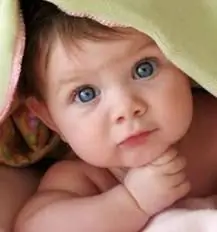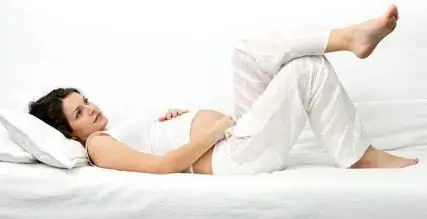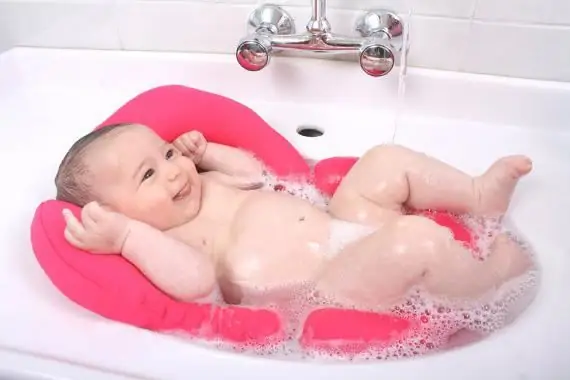2026 Author: Priscilla Miln | [email protected]. Last modified: 2025-01-22 17:55:24
The hygiene of a newborn baby requires special knowledge from parents. The first month, you need to especially carefully monitor the condition of the umbilical cord, skin folds, and hygiene of the mother's breast. Special requirements apply to bathing the baby. So, the first bathing of a child after the maternity hospital is recommended by doctors no earlier than 2 days after discharge. About what should be the hygiene of the baby of the first month of life - this article.

General recommendations for postnatal care
After discharge from the hospital, the district doctor and nurse are watching the newborn. They are required to visit the baby the next day after the mother and baby return home. He alth workers give mom advice on how to care for and feed the baby. Follow-up visits should be made by he althcare professionals on the 14th and 21st days after birth.
Among the general recommendations, the doctor draws the attention of parents to the following:
- In the first month of life, the crumbs should not invite guests to the house and visit public institutions with the baby, as well asgo visit him. This is explained by the weak immunity of the little man, when he can literally get sick from every sneeze.
- In the children's room, a certain temperature and humidity regime should be maintained: air humidity - 60%, temperature - +23 oС.
- If the baby is formula fed, then each feeding should be made from carefully sterilized bottles.
- When breastfeeding, the mother should wash her nipples after each feed, not before. This is explained by the fact that between feedings, bacteria useful for the newborn intestines are formed on the nipples, which are easily washed off if the breasts are washed before feeding. In this case, the mother must wear a clean bra with disposable pads.

Umbilical Cord Care
When a baby is born, doctors put a special plastic brace on the rest of the umbilical cord. By the 4th-6th day of the baby's life, the umbilical wound is covered with a crust, and after a month it heals completely. Modern doctors are sure that the umbilical cord does not require special care, as this can lead to infection of the wound and its trauma.
Other doctors recommend cleansing it with a drop of hydrogen peroxide (without rubbing) and then cauterizing with brilliant green (brilliant green).
There are a number of adverse symptoms that require a visit to the doctor:
- the area near the navel is red and swollen;
- an unpleasant odor comes from the wound or there is a purulent discharge;
- umbilical cord heals over tooslowly;
- protrusion formed, increasing when the baby cries.
Doctors do not recommend bathing a baby until a crust forms on the wound! The first bathing of the child after the maternity hospital in the absence of a crust is unacceptable, in this case it is enough to wash the baby and carry out morning hygiene procedures.

Washing in the morning
Newborn babies have very vulnerable skin, so it should be looked after from the first days of life very carefully. The first month you can wash the baby only with boiled water. Before proceeding with this procedure, you should prepare:
- a container with boiled water heated to a temperature of +32 oC;
- baby oil (mineral or vegetable);
- sterile cotton flagella and cotton pads;
- delicate towel (preferably bamboo).
Before washing the baby, the mother should wash her hands with soap and hot water to keep them warm and tender. Bathing rules in the morning:
- Each eye is wiped with a cotton pad moistened with water and wrung out. Movement should be from the center to the periphery. After wiping with a wet disk, you need to blot your eyes with a towel.
- The nose and ears are cleaned with cotton flagella soaked in oil. Cotton buds are not allowed!
- With a wet disc, wipe the ear and the area behind it, the nose and mouth, forehead and cheeks of the crumbs.
- Completes the process of drying with a towel - just get wetbaby skin.
After each toilet, the baby should be washed with running warm water without the use of detergents (maximum once a week). Commercial wet wipes are not recommended, as they contain many chemicals that can cause unnecessary irritation and provoke an allergic reaction. Bathing babies should also be complemented by intimate hygiene for babies.

How to wash a girl
Before you go to the bath with your daughter, you should take her in your arms in a special way: the head should lie on your elbow, and the ass will be supported by the palm of your hand. The baby is placed on the inside of the arm, tummy down. For ease of washing, baby baths for newborns are usually used, which are placed in a large bath - this reduces the risk of dropping the baby.
During the procedure, the girl should be washed from the bottom up - avoiding the ingress of dirty water into the vagina. You can not wipe the labia from the inside! After the procedure, you should blot the ass and genitals with a soft towel. In the presence of irritation, the skin should be treated with a special agent.

How to wash a boy
Before going to the bath, the baby should be picked up in the same way as above. When washing, water should be directed from front to back. The scrotum and penis should be washed gently, without pulling the delicate skin or exposing the head of the penis.
After water procedures shoulddry and lubricate the skin in case of irritation.
What to do with crusts on the head
After birth, babies often develop yellowish crusts on their heads - the so-called gneiss. The reason for its formation is unknown. It is assumed that its appearance may be associated with the reaction of the baby's body to food.

To get rid of crusts on the scalp, you should prepare vegetable or mineral oil, a cotton pad and a small comb. One hour before bathing in the bathroom, you need to lubricate the crusts with oil, previously boiled in a water bath. Bathing babies should be supplemented by wiping the gneiss with a soapy cotton swab, followed by combing. When the hair is dry, remove the remaining scales by combing out with a comb.
Baby bath
If a crust has formed on the umbilical wound, there is no inflammation and discharge from it, then you can start washing the crumbs. As a rule, the first bath of the child after the hospital takes place a couple of days after discharge.
The first month of a child's life, water procedures should be taken every day. Starting from the second month - every other day. By six months, it is enough to bathe the baby a couple of times a week. Don't do this too often as exposure to chlorine water can damage your baby's skin.

Bathing should be done at the same time each day, preferably before the evening feed. Duration of water procedures - up to 6 minutes. Baby's first bathafter the hospital can scare him, so 1-2 minutes will be enough to start. If the baby starts crying, the procedure should be stopped. You need to bathe on a full stomach so that the child does not act up. You should not take a bath after 21:00, as this will have an exciting effect on the nervous system of the crumbs, and it will be more difficult to put him to bed. Bathing water for newborns should be around +23 oS.
If necessary, bathing string or chamomile can be added to the water, but it is not recommended to bathe the baby in manganese water. Potassium permanganate dries the skin very strongly and is very dangerous in terms of causing burns with crystals of the substance. In the first month of a child's life, settled and boiled water should be used to get rid of excess chlorine and other harmful elements. For the procedure, you can use baby baths for newborns - they do not require large amounts of water.
When bathing a baby, hold him by the head and neck with the left river, and pour water over the body with the right and wipe the skin. Upon completion of the procedure, the child should be doused with water that has a temperature 2 degrees lower than that which was during bathing.

Handling the diaper
This accessory makes life a lot easier for parents, but comes with a few requirements.
- Before going outside, after emptying, half an hour after feeding, the diaper should be changed.
- After removing the diaper, you need to allow the skin to "breathe" for 40-60minutes.
- If there is irritation on the skin, you should stop using this item for a while. Alternatively, regular diapers, washed and ironed, can be used.
- If an allergic rash appears in the diaper area, you should immediately replace it with products from other manufacturers.

Following these simple requirements will avoid unpleasant consequences in the form of sweating, allergies, diaper rash and other troubles.
Recommended:
Does a newborn baby hear: features of hearing in children after birth

Someone believes that babies begin to hear already in the womb, and someone believes that newborn children at an early age do not yet perceive the surrounding sounds. Who is right? Consider how a child's hearing is born, how it develops. Pay attention to the signs of hearing impairment
The first days of a child's life. Newborn care

Every woman in labor is looking forward to the arrival of her baby, because tense nine months have exhausted her internally. Therefore, the first days of living together with a child for a mother are a kind of liberation
How many days can I get pregnant after my period? How fast can you get pregnant after your period? Chances of getting pregnant after period

Pregnancy is a crucial moment for which every woman wants to be ready. To determine the probable moment of conception, it is necessary to know not only the time of ovulation, but also some features of the human body
What to do to endure and give birth to a he althy baby after 35? How to give birth and raise a he althy child: Komarovsky

How to give birth and raise a he althy child to a woman of non-fertile age? What risks does she take and what consequences can the child expect? How to prepare for late pregnancy and cope with it?
How many days from conception to birth? How to determine the date of birth?

Pregnancy is both a joyful and exciting stage in a mom's life. Pregnancy teaches us to wait. But you want to know in advance the long-awaited day of meeting with your beloved baby! How to calculate the expected date of birth and what methods are the most effective, the article will tell

